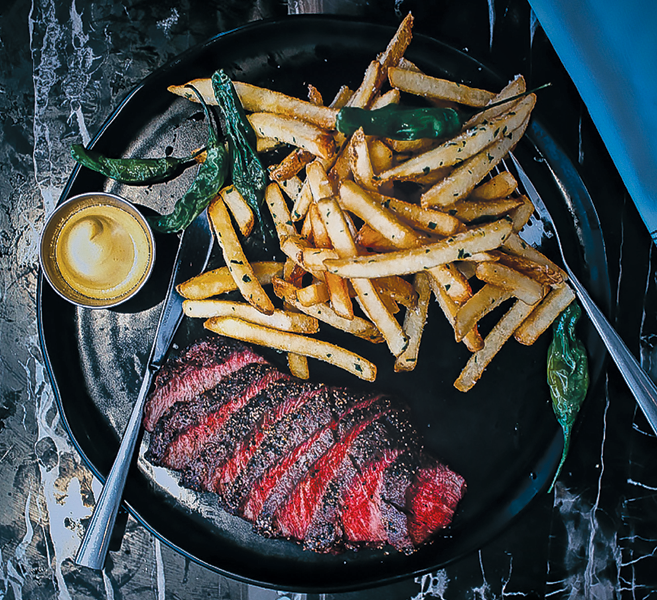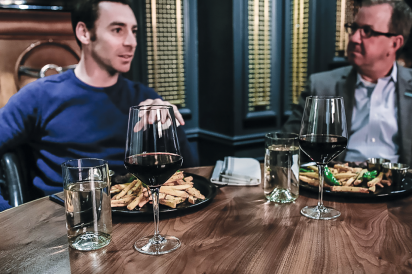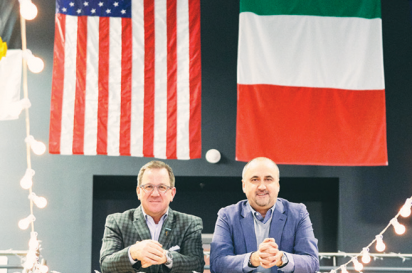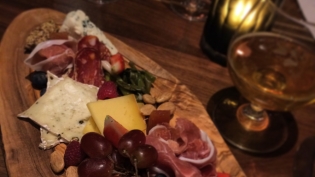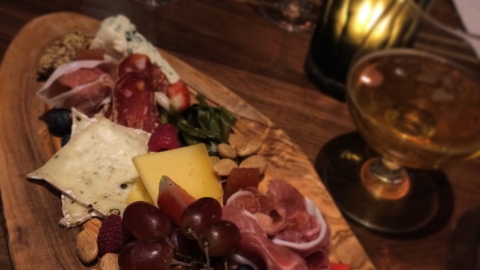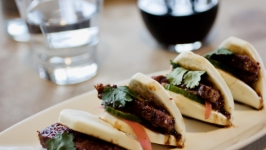The Taste of Friendship
Order the Pagenaud Steak Frites or the Saffron Risotto dePonti from the Spoke & Steele (S&S) menu, and you’ll know from the first bite that these dishes are made from the finest ingredients, exquisite European cooking techniques and unique flavors combined to perfection.
What you won’t be able to taste, however, is that these signature dishes, created in collaboration with IndyCar driver Simon Pagenaud and Dallara LLC CEO and General Manager Stefano dePonti, were also made from friendships, forged between cultures and cuisines.
An Idea Is Born
The idea began when Le Meridien Indianapolis General Manager Chris Ratay met Pagenaud, a native of France, to talk about the French hotel brand Le Meridien, which is connected to S&S. Pagenaud, known as the “foodie” of the IndyCar circuit, and Ratay had plenty to talk about. When the conversation turned to which one dish would best represent Pagenaud’s tastes, the answer was simple.
“I told him straight away it’s got to be a nice piece of meat and some nice fries with some mustard,” says Pagenaud, a member of Team Penske. So Ratay made an offer: What if steak frites, developed and approved by Pagenaud, became a signature item on the S&S menu?
“They’ve managed to find a way to do that with my touch of sophistication,” says Pagenaud, who knows his way around a steak. Ratatouille is another specialty of Pagenaud’s, who regularly grills and cooks for family and friends at his North Carolina home when he’s not traveling on the IndyCar circuit.
In fact, Ratay invited Pagenaud into the kitchen to cook with the S&S executive chef. Pagenaud Steak Frites, now a favorite on the S&S menu, is made with a prime flat iron steak, seared then cooked arroser, a French technique of basting in butter infused with garlic and thyme. A few Shishito peppers, or peppers currently in season, are added, and the steak is finished in a hot oven. Just before it’s served, the steak is sliced, laid next to the frites and sprinkled with a generous helping of Parmesan cheese.
Food Passions
Ratay’s friendship developed a little differently with dePonti, whose Dallara engineering company is the sole supplier for IndyCar chassis. The two met months earlier through mutual friends, and one evening the pair ended up with a group at a friend’s apartment. It was getting late, and everyone was hungry, so dePonti politely excused himself, made a quick trip to a nearby supermarket and came back to whip up a homemade carbonara for about a dozen people. Of course, he cooked it the Italian way, with only eggs, pasta, pasta water and a whole lot of Pecorino Romano. And Ratay immediately took notice.
“That night was when I found out he is a carbonara aficionado,” Ratay says. “And that was also the night I came to understand his passion for food as well as his engineering passion.”
So Ratay invited dePonti into the S&S kitchen, as he had with Pagenaud, to prepare what became known as Carbonara DePonti with the executive chef. Soon the classic Italian dish was added to the menu as another signature item.
Months later, when the weather turned cool and S&S’s seasonal menu was evolving, dePonti suggested a new eponymous item, Saffron Risotto, another popular dish in Northern Italy where dePonti is from.
“I don’t think there is anyone preparing Saffron Risotto in Indianapolis. Nobody. Because quality saffron is relatively expensive,” Ratay says. “At least nobody’s doing it like this, where you can actually see the pieces of saffron in the dish. It is a bit expensive. But it’s delicious!”
Authentic International Influence
In addition to the infused saffron, S&S’s Saffron Risotto DePonti is made with Italian sausage and lots of Parmigiano Reggiano, and served with a few fresh green beans. Though in Italy, there would be no such side dish. It’s a detail both Ratay and dePonti point out, not to be nitpicky, but to explain the addition as an intentional choice in an otherwise authentic dish.
It’s the same reason the Pagenaud Steak Frites is served with Amora mustard, imported directly from Dijon. It’s a favorite of Pagenaud’s, but it’s also how steak frites is eaten in France. Tapping into the best of the European cultures that these two men represent results in something special for S&S.
Eating Dinner the French Way
According to IndyCar driver Simon Pagenaud, eating dinner in France includes so much more than a quick salad standing at the kitchen counter or a drivethrough hamburger and fries eaten in the car on the way home. The meal always includes other people and is entered into and enjoyed slowly.
The following French terms help explain the French way of eating dinner.
Aperitif: The evening starts with cocktails at the bar, used to stimulate the appetite and to bring the dinner guests together.
Amuse-bouche: Along with the drinks, small, bite-sized hors d’oeuvres also are served to help prepare guests for dinner.
Une entrée: Once guests are seated at the table, an appetizer or starter is served. (Note: The English use of entrée means main dish, but in French it’s used differently.) This is a more substantial starter that may include soup or a few chopped vegetables.
Le plat principal: When the main course is served, the portions are smaller than on an American plate. After all, this is the third course.
Le fromage: Cheese is so important to the French culture that some French tables include cheese as its own course after the main dish is served.
Le dessert: Of course there will be dessert. Next to wine and cheese, the French are best known for their pastries and chocolates. But not every French dinner ends with such rich treats. Sometimes, dessert is a bowl of fruit or yogurt. Or sometimes, the cheese course is the dessert.
Le café: As the meal is wrapping up and dessert is over, coffee is served. But you can put away your giant morning mug. After-dinner coffee is usually a simple espresso, possibly with a little sugar, but never milk.
Un digestif: When the table is cleared, guests gather for a final course of afterdinner liqueurs, often taken straight. Sometimes, bitters are served, which are thought to enhance digestion.
Eating the Italian Way
Because he has lived in and traveled around the U.S. for more than a decade, we were sure Dallara LLC CEO and General Manager Stefano dePonti would have a favorite meal to recommend. His answer wasn’t what we expected: “Every state I eat in has the best meal,” he says.
But his response made perfect sense once he explained his belief that the best meal always includes the food most closely connected to each particular place, both geographically and culturally. “Everywhere you go you must try something different according to what the region can offer,” he says. “This is my philosophy for enjoying food.”
“If I go to Vail, Colorado, I’m not looking for a seafood place. I’m not looking for a lobster up in the mountains. Just like when I go to Key West, I’m not looking for a bison steak,” dePonti says. “I’m looking for something closer to what we call Zero Kilometer, or what’s local to the area.”
This concept, referred to in Italy as Km0, stems from a core commitment to using fresh, local ingredients and fits comfortably with the Slow Food movement. In addition to the culinary and nutritional benefits, Km0 also is good for the environment and for local economies.
To bring it closer to home, dePonti offered tomatoes as an example. Who in Indiana hasn’t cut into a pale, mealy imported tomato in the winter and vowed never to eat another until summer?
“You don’t eat local tomatoes in December and January because there are no such veggies available during that period of the year,” he says. “So you eat something more seasonal.”
Of course the local food movement isn’t unique to Italy. In the last two decades, many U.S. restaurants, institutions and consumers have embraced a more local approach to eating.
But according to the Boston Globe’s Sheryl Julian, who wrote about the Globe tour of Tuscany and Liguria back in 2015, Km0 isn’t just a movement in Italy; it’s a way of life.
“Italians never mention the words ‘locavore’ or ‘farm to table,’” Julian writes. “They just do it—with immense regional pride.”
“For us to have authentic international influence on our menu is something very special,” Ratay says, “especially to the level that it’s actually attached to a person, and it’s really fun.”
“Chris is not inventing anything,” dePonti adds. “He’s able to bring to his restaurant, to his table, dishes that are already there all over the world so that people like me have more choices.”
Relationships Around the Table
But it’s not just the international food itself that these friendships bring to S&S. The relationships Ratay has forged with Pagenaud and dePonti bring with them the European emphasis on simplicity, Zero Kilometer and, of course, relationships around the table.
“Friendship around a glass of wine and food is just everything to me,” Pagenaud says. “It’s time to talk about their stories, your stories, joke, talk about the future and the past. When you’re with family, stories of the past always come back. It’s like traveling in time, being at the table. That’s what it’s all about. That, and the enjoyment of the food.”
Pagenaud says that American friends who come for dinner at his house are always surprised that he actually eats at the table. “And they always feel bad at the beginning because I’ll be sitting at the table alone eating and at some point they turn back to me and are, like, ‘We’re sorry, we’re finished’ and I’ll say ‘Yeah, you finished and you left me. This was supposed to be a moment together,’” he explains, laughing. But over time, those same friends have begun to linger at the table with him. “They really understand the tradition and what it means to me, and it seems like it’s starting to mean something to them too,” Pagenaud says.
DePonti agrees. He says food is more than just “fuel for the engine.” It should be enjoyable, of course, but food also is a reason for people to come together.
“In Europe and in Italy there’s still a strong tradition of sitting at the table together when we eat,” dePonti says. “The food is the medium, and then you talk about problems, opportunities, your kids, your kids’ new school, everything. The food brings you together.”
The Business of Storytelling
This international perspective on both food and culture is something Ratay has come to rely on at S&S.
“Having people like Stefano and Simon to validate what we’re doing is important because we need the feedback. We want to be the best,” Ratay says. “What Stefano and Simon do for me is keep me passionate about being the best. I know they will tell me the truth and provide us input to make something that people are going to love and remember and come back for.”
Of course, the friendships also make great stories.
“In this business, storytelling is very important. What separates a restaurant experience is being able to tell a story about what someone is about to eat,” Ratay says. “Every night at S&S we can talk about these dishes in terms of real people who inspired them and who have a fascinating story and are connected to the community.”
It also makes a great story for dePonti, who often brings clients into S&S. According to Ratay, dePonti often gets embarrassed when clients see the signature item and ask how he was able to get a dish named after himself on the menu. “I tell them it’s not me, it’s somebody else,” dePonti says, laughing.
Ratay laughs, too, a full, comfortable laugh, the kind you express only when you’re with friends.
“When it comes down to it, isn’t this just a lot of fun?” he says. “I think that’s what we’ve created with Simon and Stefano, just even more fun than this business already provides.”
Eating the Spoke & Steele Way
Spoke & Steele opened in December 2014 on the first floor of Le Meridien Indianapolis hotel. The 180-seat restaurant draws its inspiration from the emerging creative neighborhoods and familiar feel of downtown Indianapolis and includes a dining room, bar, private dining area and specialty drinking room.
Though S&S is in a hotel, it’s more than just a “hotel restaurant.” As Le Meridien Indianapolis General Manager Chris Ratay describes it: “We’re a restaurant with 100 rooms.”
The current S&S culinary family includes:
Greg Hardesty: creative culinary consultant
Erin Gillum: chef de cuisine
Nick Simpson: sous chef
Emily Nicoson: S&S general manager
Ramona Adams: S&S group and special events manager
Spoke & Steele | 123 S. Illinois St., Indianapolis | 317.737.1616 | SpokeandSteele.com


